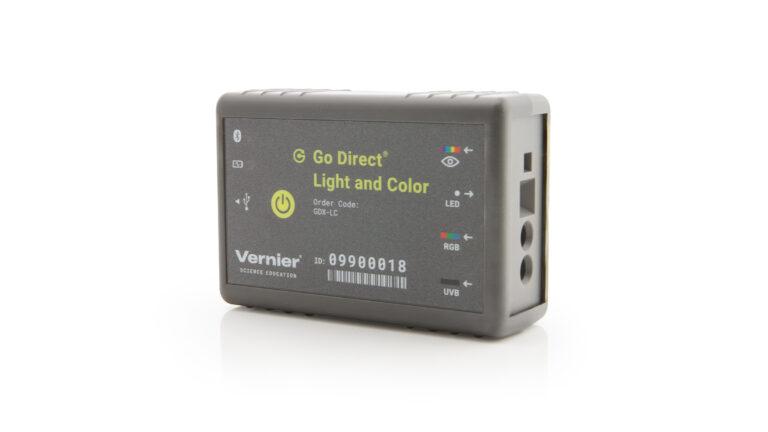Troubleshooting
General: Press the power button on the sensor to turn it on. Connect your sensor as described in the Getting Started instructions for your device.
- Primary Test: Select the desired channel(s) from the list of available sensors (see, How can change the sensor channels used with data collection for Go Direct sensors having multiple sensor channels?). Expose the light aperture to a variety of UV, visible light, and/or colors and confirm that the sensor reading responds appropriately. Press the power button to toggle the white LED on and off.
Additional Troubleshooting
- How do I turn the Go Direct Light and Color sensor white LED on or off?
- What is the UV Index and how is it calculated?
- Do the colors of RGB color sensor traces correspond to the red, green, and blue colors?
- What does the UV sensor in my Go Direct Light and Color sensor measure?
- What do the 650 nm, 550 nm, and 450 nm channels measure in the Go Direct Light and Color sensor?
- Go Direct sensor does not connect to LabQuest 2 via Bluetooth.
- How many wirelessly connected Go Direct sensors can I use for data collection at the same time?
- Troubleshooting Bluetooth Connections with Go Direct Sensors
- What can I do if a Go Direct sensor's Bluetooth LED flashes red and green when I try to connect to it and the connection fails?
- Will my device work with Go Direct Sensors via Bluetooth?
- How do I know if my LabQuest will work with Go Direct Sensors and Go Wireless devices?
Specifications
- Visible Light Sensor
⚬ Wavelengths: 400–800 nm
⚬ Range: 0 to 150,000 lux
⚬ Resolution
▪ ±0.2 lx (less than 10,000 lux)
▪ ±5 lx (greater than 10,000 lux)
⚬ Maximum sampling rate: 1,000 samples/s - UV Sensor
⚬ Half-sensitivity Range (approximate)
▪ 260 – 315 nm (serial numbers starting with 099) – UVB
▪ 300 – 425 nm (serial numbers starting with 096 or 097) – UV + Blue
▪ 320 – 375 nm (serial numbers starting with 091, 092 or 093) – UVA
⚬ Maximum sampling rate: 1 sample/s
⚬ Response Time: 0.4 s - RGB Sensor
⚬ Intensity Range: 0 to 1,000 (relative scale)
⚬ Peak Response
▪ Red: 615 nm
▪ Green: 525 nm
▪ Blue: 465 nm
⚬ Maximum sampling rate: 0.5 sample/s
⚬ Response Time: 0.4 s - Dimensions: 8.8 cm x 6.0 cm x 3.2 cm
- Connections:
⚬ Wireless: Bluetooth® v4.2 (wireless range 30 m unobstructed)
⚬ Wired: USB 2.0 full speed - Battery: 300 mA Li-Poly
⚬ Battery Life (single, full charge): ~24 hours continuous data collection
⚬ Battery Life (lifetime): 2 – 5 years (typical)
Calibration
Calibrate? No. The sensor is set to the stored calibration before shipping. If you wish to calibrate the sensor, you will need to conduct a two-point calibration. For more information, see How do I calibrate my sensor?
Battery Troubleshooting
- If the sensor can be turned on when connected by USB but not when disconnected from USB, the battery either needs charging or has reached its end of life and can no longer hold a charge.
⚬ First, try charging the sensor for several hours. - If the sensor still won’t turn on when disconnected from USB, try swapping the battery with a working sensor to see if the problem follows the battery or stays with the sensor.
⚬ If the problem stays with the sensor, the battery is probably not the issue.
⚬ If the problem follows the battery, the battery has likely reached its end of life. - If you intend to use this sensor wirelessly, its battery will need replacing.
Go Direct® 300 mAh Replacement Battery (GDX-BAT-300 ) - See How do I remove or replace a Go Direct battery? for more information (including a video).
Rechargeable batteries are covered by a one-year warranty.
Batteries should last two to five years in typical use.
Related Products
- Micro USB to USB-C Cable (
CB-USB-C-MICRO ) - Go Direct® Charge Station (
GDX-CRG ) - Sensor Bracket for Go Direct® (
GDX-MOUNT ) - Light Sensor (
LS-BTA ) - UVA Sensor (
UVA-BTA ) - UVB Sensor (
UVB-BTA )
Replacement Parts
- Go Direct® 300 mAh Replacement Battery (
GDX-BAT-300 ) - Micro USB Cable (
CB-USB-MICRO )

